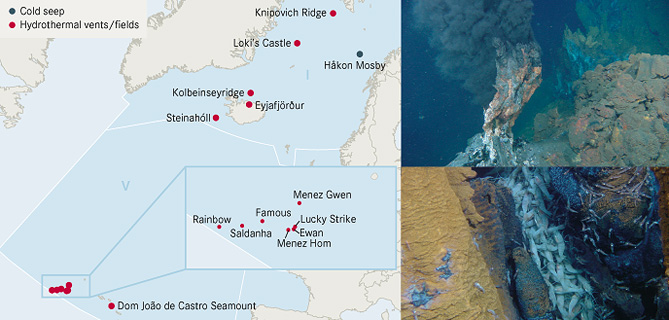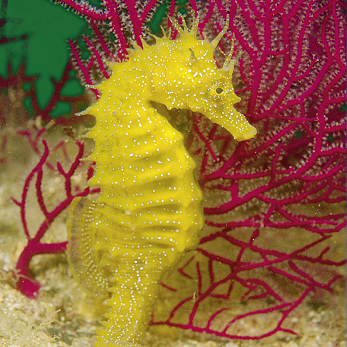Hydrothermal vents occur around submarine hot springs or superheated jets. The mineral-rich water supports biological communities that derive their energy from dissolved chemicals, such as hydrogen sulphide (H2S), rather than from solar radiation. One typical form of hydrothermal vent, a ‘black smoker’ is shown in the photo below (upper). The plume consists of hot water escaping from the seafloor containing (black) metal sulphides. Chemotrophic bacteria metabolise the H2S and support a unique community of animals that feed on them, or with which they have long-term interactions. The photo below (lower) shows a specialised community of hydrothermal vent shrimps. Hydrothermal vent fields in the OSPAR area (see map) occupy small areas of the seabed at depths of 850 to 4000 m, associated with the Mid-Atlantic Ridge in Regions I and V. Vents are relatively short-lived, generally existing for only a few decades, thus the exact number and locations of vents are not known.
Cold seeps occur where methane and H2S are released from the seabed at near-ambient temperatures and also provide energy for a bacterial-based food chain. They are common in European waters and can form a variety of large-scale to small-scale features on the seafloor. The Håkon Mosby mud volcano is one of the largest such features in the OSPAR area, measuring over 1 km across. The communities on different cold seeps frequently differ in terms of species composition. This indicates that there is a high variability in ecosystem processes and associated biodiversity at different spatial scales.
The physical structures of vents in particular may be at risk from activities such as mineral extraction, bioprospecting and, in future, tourism. Scientific research can also cause physical damage. Protected area designation is among the approaches being taken forward to manage human impacts on hydrothermal vents. OSPAR has agreed a code of conduct for responsible marine research in the deep seas and High Seas of the OSPAR area.

Background document for oceanic ridges with hydrothermal vents

